Yesterday's Random Photos
/Sheep shearing, yarn photos, and a pregnancy photoshoot with sheep at sunset.
Read MoreJuly, 2023: I have switched to writing most of my blog posts on my original WordPress blog so access all the current news there and sign up on that site for email updates.
Sheep shearing, yarn photos, and a pregnancy photoshoot with sheep at sunset.
Read MoreThe second part of the Shearing Day post.
Read MoreShearing Day on January 29, 2023. This post is Part 1.
Read MoreA second post about shearing at the Timm Ranch.
Read MoreEvery year I get wool from the Timm Ranch, about five miles from here, and have it made into a really great yarn. I sell the yarn in skeins and on cones and I use a lot of it for my own woven products. I could probably substitute blog posts from previous years for this one and you wouldn’t know the difference. Same place. Same sheep. However some of the Farm Club people have changed. So here is the 2022 Shearing Day last week.

The Timm Ranch sheep are what I like to call a ranch blend of Polypay, Rambouillet, and Targhee. That means that those are the original breeds in the flock but over the years, as the Timms have raised their own replacements, the individual breeds aren’t so recognizable. The sheep have traits of all, but most of what we are happy to see is the fine wool traits of those original breeds.

The sheep moved into the lane on the north side of the barn.

Last year there we tried to keep up with two shearers. This year there was only one and we were able to keep pace with him.

The shearer is known as Junior and this logo is a new one.

Several Farm Club members came to help evaluate and skirt fleeces.

We worked at two skirting tables.

The goal was to check the fleece for soundness (most were fine in that respect) and then skirt. Skirting is to remove the parts of the fleece that are of lesser quality—wool at the edge of the belly and that with excess VM (vegetable matter). The timing was just right for shearing and there was very little VM in the fleeces. All waste was bagged for a friend with a project in which she will make a product from wool that will otherwise be discarded. That will be a blog topic later on.

We kept a running tally of the weight so that I could make sure I reached my 200 pound minimum and I could figure out how much to pay for the wool. The skirted fleeces varied from 4.5 lb to 9.5 lb. and I ended up with 222 pounds in one pile and 50 pounds in the other.The wool will go to two different mills.

Some of the sheep after shearing.

The sheep were in two groups. The largest group had fall lambs, but there was one group with lambs born more recently—including the previous night (although that pair was still in a lambing pen). At one point Susan and I walked over to the group with young lambs and they followed her to the barn.

These are locks from some of the fleeces we chose. The yellow paper is 5” wide so you get an idea of the fleece length. There were a handful of extra long fleeces. One was from a sheep that was missed last year so that was a two year fleece—too long to combine with this batch. Some of the other long ones were from replacement ewes born in the fall of 2020 and not shorn last spring. We tried to sort by length and most of the 200+ pound batch is about 3 to 4 inches. The longer ones are mostly in the other batch of wool.
Stay tuned for another post with more photos.
A follow-up to the first shearing day post, including before and after photos of some of the sheep.
Read MoreShearing Day at Meridian Jacobs—we sheared over 80 Jacob sheep.
Read MoreIt feels like the night before Christmas! …All through the barn the sheep are waiting…The barn is organized. The tools are hung (where is that strike-out thing when you need it—I wanted to say stockings but cross it out) . The rams have been moved to the barn. The water is turned off (empty stomachs are better for shearing). ETC.

Dan did this job earlier in the week. The gate we used to have here didn’t fit the space and I had a panel wired up to stick out into the doorway a couple of feet. The reason is that when the gate swings open (towards me when taking this photo) it would stick out into the south doorway to go in and out of the barn. That is not very pracrtical. So Dan designed and made a folding gate.

Here is is in use. Clever, isn’t it?

Yesterday we went to a friend’s place just up the road to pick up her Jacob sheep and bring them here for shearing. There are 16 or 17 ewes and one ram. This is the ram, born in 2021.

The next few photos are some of her ewes. They weren’t crazy about getting their photos taken—or maybe it was about me being in the pen with them.

A couple of pretty ewe lambs.

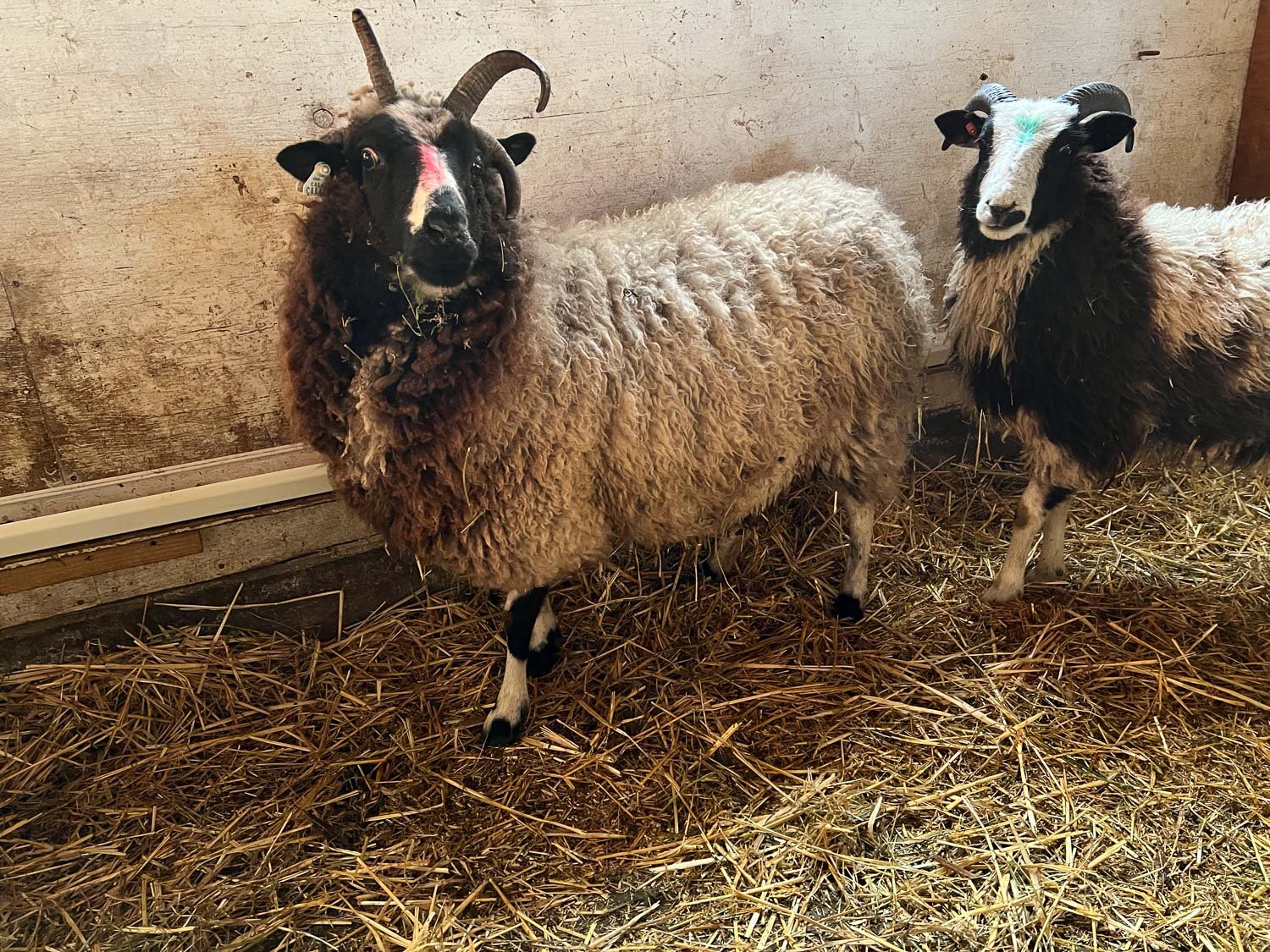
It will be fun to get hands-on these sheep and see their fleeces. We sheared them last year as well and they were a lot cleaner than mine as far as the vegetable matter goes—probably because they have winter pasture and are not being fed as much hay.

Tonight I brought my rams over to the barn so that I don’t have to deal with them in the morning. This is Rambler. He’s still a yearling—coming up on 2 years old in March.

Rambler’s fleece

Silverado (Ruby Peak Tamarisk x Meridian Spice), born almost a year ago in 2021.

Meridian Axis, a lilac ram also born in 2021. (Meridian Axle x Meridian Vixen)

Hillside Gabby’s Barrett, the ram lamb I got from the Hillside Farm in Michigan last summer. He is maturing nicely.

Barrett’s fleece.
Remember what I said about the Night Before Christmas? I’d better get to bed and read for awhile to turn my mind off so I can sleep. What’s that? Do I hear little hooves on the roof? Did I shut all the gates in the barn?
This is the sixth year that I have purchased wool from the nearby Timm Ranch on their shearing day. Here is an example of the yarn that is spun from the wool and there is a little bit of info about the ranch and the flock at that link.
We were so lucky with the weather. The shearing had already been postponed because of potential rain and if there had been the north wind as the day before it would not have been nearly as pleasant.

The sheep are what I call a ranch blend of Rambouillet, Polypay, and Targhee, all fine wool breeds.

There are not individual sheep of those breeds, as the ranch has raised their own replacements for quite awhile.

I’m glad that so many Farm Club members were able to help because there were two shearers working and we needed to keep up with them.

As a fleece was shorn Alan took it from the shearers and put it on a tarp near the skirting tables.
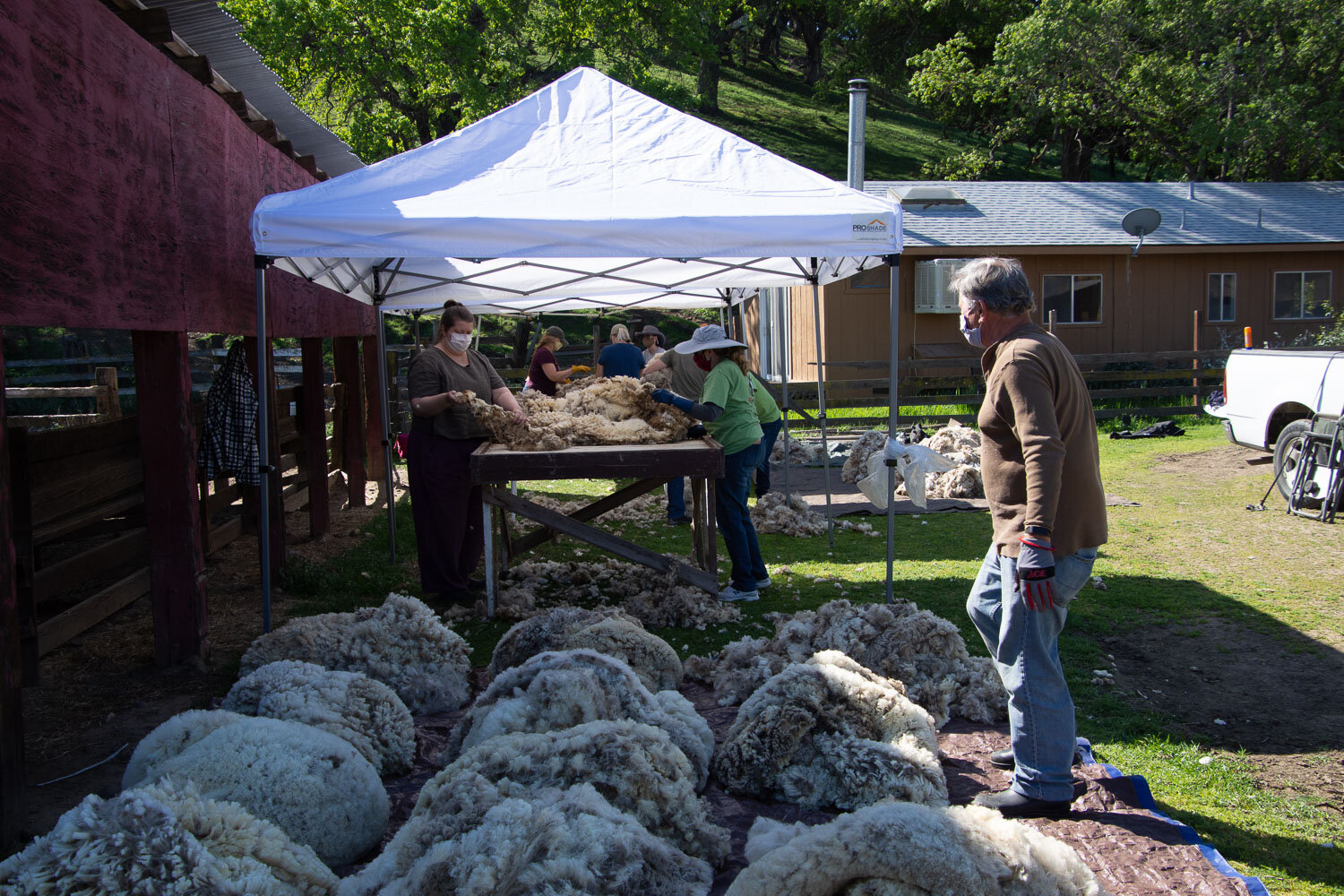

After the first few years of working at the shearing we figured out that we’d better bring canopies or we’d be in the sun the whole day. It was looking very festive here—the canopies cover three skirting tables.

We kept up the safety protocol and everyone wore masks. Some of the Farm Club members had been to this shearing in previous years and it was new for others. Susan, Marina, Kimber are in this photo (I think that I’m able to see who is behind the mask.)

Teresa and Doris are here.

Beth, Carol, and Sylvia.

Thanks for this photo, Doris. I am in this one.
At a commercial shearing operation, the classes and skirters have seconds to spend with each fleece if they hope to keep up with the shearing when 6 or 7 shearers are working. We are a lot slower. The reason is that I feel compelled to send wool that is as free of VM (vegetable matter) and other faults as possible. When we skirt we remove any part of the fleece that isn’t up to a chosen standard. We pull off wool from around the edges where there is going to be more debris or felting, wool with paint markings, wool that has more VM, and wool that may be tender (brittle) or short. The huge mills have processes that deal with VM chemically: Carbonising is a continuous process which combines scouring to remove the wool grease and a chemical process which removes vegetable matter such as seeds, burs and grass. Carbonising occurs if the greasy wool contains a high percentage of vegetable matter (%VM), typically in excess of 2% to 3%. There is more info at this link. My wool is going to a mill that doesn’t do that process so it is important to send only wool that is as clean as possible.
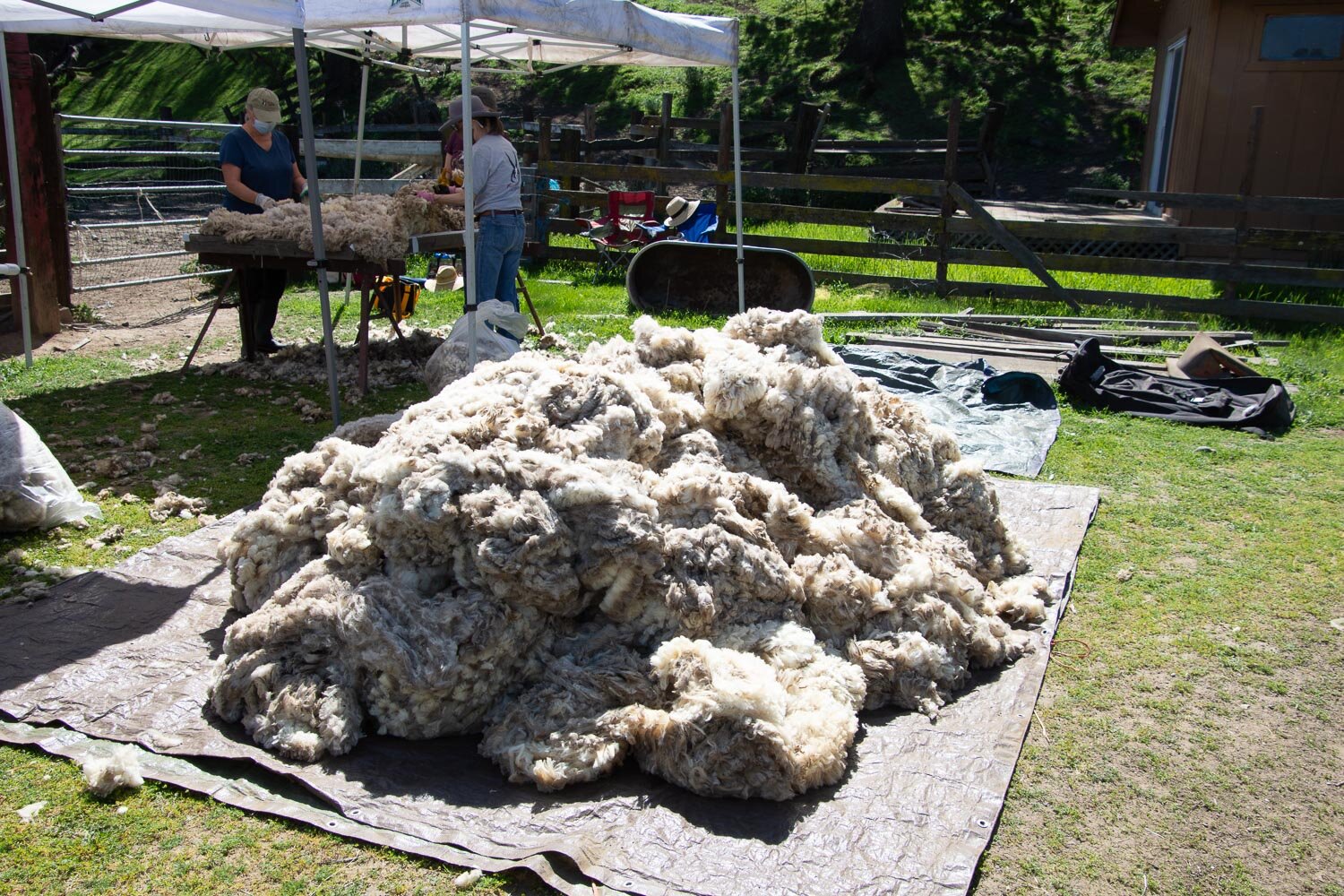
I also needed to keep track of how much wool we had because I needed to meet a minimum of 200 pounds for the mill where I’m sending this wool. So after skirting fleeces we filled bags to be weighed. After recording the weight the wool was piled on a tarp to be baled at the end. The reason that we had to keep up with the shearers is that they brought the wool press with them. They would press our wool and any that we didn’t take into bales before they left. It was important to not have to stuff this pile into bags and boxes, but to get it into a bale for shipment.

Much of the ranch property burned in the devastating LNU Complex fire last summer, but the buildings at this location were spared, probably because the sheep graze the 80 acres that is right around the headquarters.

They were certainly lucky that these old barns didn’t burn.



Our pile got to 230 pounds as the shearers were finishing. They dragged it over to the wool press.


I wrote a post about Shearing Day a couple of days ago but there was more!

There were photos of Ginny and Oakley (the shearer’s dog) in the last post. Rusty even wanted to play. Not bad for an almost 15 year old dog.

The last post ended up with a lunch break. (Too bad we couldn’t have the fabulous potluck that has happened in other years.) I had brought a friend’s sheep here to dry out and stay dry so they could also be shorn. They were the after-lunch group.
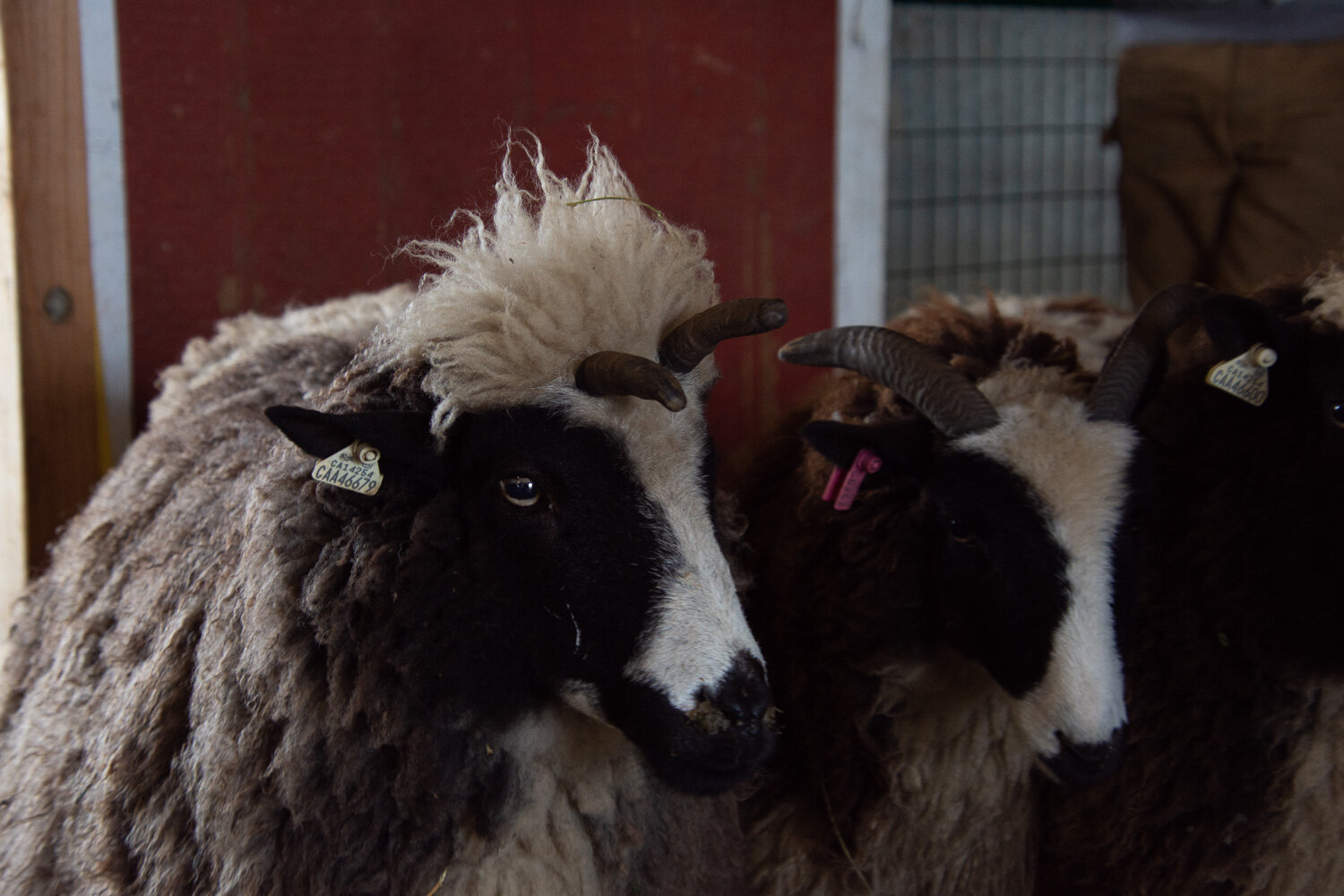
We were amused by this sheep’s fluffy hairdo.

I watched this sheep butt others with her horns and she must have been doing that earlier to come in with this look.

Farm Club members helped clean the barn after we finished shearing, and they valiantly braved the lake to dump the wheelbarrow loads.. This is what happens after only 2” of rain.

They also spent time looking through fleeces.

After finishing with all the sheep I like to take some photos of how they look without fleece.

This is Sheila.

Meridian Axle.

Ruby Peak Tamarisk, on the left, is the sheep I picked up this summer in Oregon (blog post here). Meridian Jasper is on the right.

Rocky is a wether whose only job is to be a buddy sheep when I need to move someone else (usually a ram) into separate quarters.

Peyton is the BFL ram who weighed in that morning at 281 pounds!

Farm Club members took some of the fleeces but there are still a lot left.

Shearing Day was 5 days ago on 1/29. I can’t believe that I haven’t shared photos yet. I often think in terms of photos and blog posts, but they don’t always make it to the computer. The first post I meant to write was about getting ready for Shearing Day.

Tuesday night the area was hit with a wild storm and huge winds. On Wednesday we drove to a friend’s farm about 5 miles away to bring her sheep to our place so they would be dry for shearing. We now know how many sheep we can put in our trailer—that would be 20 in full fleece. The sheep were soaked but by bringing them here they had a chance to dry out and our shearer added them on after shearing our sheep..
Tuesday night our power went out and stayed out for almost 24 hours and we were luckier than many to be out of only that long, especially since I didn’t think John would want to hand shear 88 sheep.

Wednesday morning I got the barn organized for shearing. I found the plywood we save for shearing next to the stack of straw. It looks as though last year someone labeled it so that it wouldn’t be cut up and used for something else before this year. Good idea.

We started with the rams. This is 2 year old Jasper.

Shearing Day is usually an Open House and we have a lot of visitors and fleece buyers. This pandemic year was an exception, but I was glad that some Farm Club members could come and help. In fact they did most of the work of moving sheep and handing them off to John.

Sheep-eye-view of the holding pen.

The whole day went so smoothly. Everyone had a job and knew what to do. The few brand new Farm Club members jumped right in as well and the “old-timers” showed them what to do and talked about handling sheep.

John sheared 8 rams and wethers and then moved onto the ewes.

Mary scooped the fleeces off the shearing board and her husband, Russ, held the bag open for the fleece.

Kathleen was happy to do her regular job of weighing fleeces.


As usual Ginny entertained herself with the ball. This time she put the ball through the fence where John was shearing, hoping that someone would throw it for her. This time John’s dog, Oakley, picked it up and they both ran off.

Later Oakley found a piece of horn which I think he liked better than the ball.

John sheared all 68 of our sheep and then took a break before shearing the my friend’s 20 sheep.

While John ate lunch we held a raffle that was open to those members who had renewed their membership. We raffled off the shawls that our Meridian Jacobs teams had woven at 2019 Black Sheep Gathering and 2020 Lambtown Sheep-to-Shawl contests. It was fitting that Marina won the shawl woven by the team she was on in 2019. Two other members who couldn’t be at shearing will pick up the Lambtown shawl and another that I wove as a sample before the Lambtown competition.

The ram lamb (almost a year), Rambler and his wether buddy in the background. Remember this look—you’ll never see him this white again.
Stay tuned for more shearing photos tomorrow!
The injury that I talked about in the last post has kept me from doing a lot of my normal stuff. I’m way better but my motivation isn’t there and everything (including taking decent photos) just seems hard.
Farm Club member Dona took a lot of photos of the winter and early spring events going on here and I’m finally getting to a blog post where I’ll use them. Thanks Dona.

Shearing was in early February. Thanks to Farm Club for doing all the work involved in making Shearing Day go smoothly.

Farm Club members went home with their fleeces and other fleeces were sold.

The sheep just kept on coming.
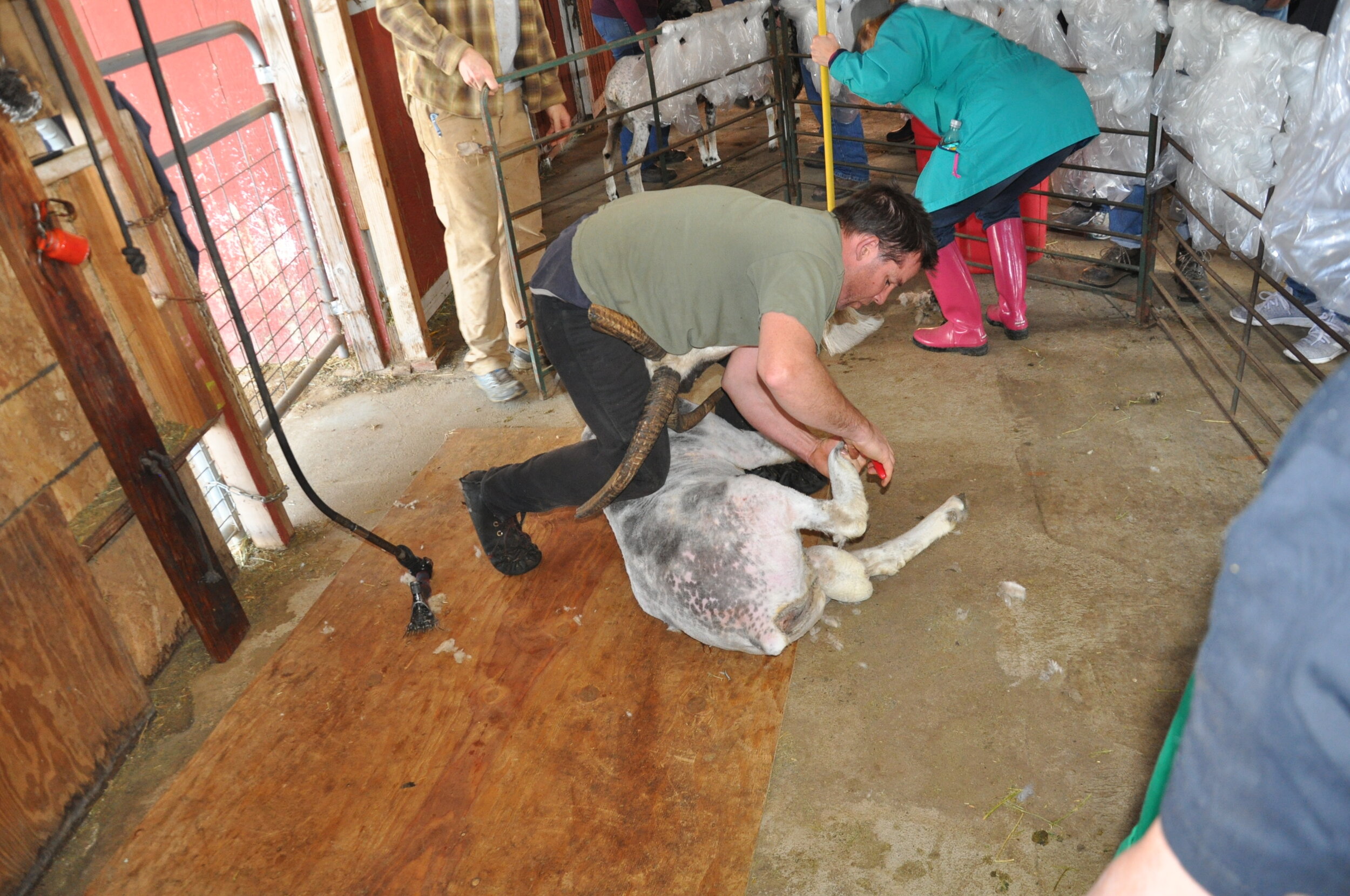
Since I’m not going to be ready to trim feet for awhile our shearer trimmed each sheep as he finished shearing.

Farm Club members and fleece buyers were able o skirt fleeces before they took them home.

The goats were probably glad that they didn’t need to go through the shearing gate.

Lincoln was the youngest person at Shearing Day and I know that in future years he will be a fixture at area fiber events.

Hank is another well-known fiber-immersed baby.

The rams don’t look so impressive after shearing. This is Meridian Axle.
At Meridian Jacobs farm we raise Jacob sheep and sell locally grown wool fiber, yarn, and handwoven goods. We teach fiber classes and sell Ashford, Clemes & Clemes, and Schacht spinning and weaving equipment. We encourage farm visits with field trips and our unique Farm Club.
Search blog posts since 2019. If the search says it can’t find a post try putting in your search word a second time. I don’t know why but the second time it seems to work.
Search the entire website, including older blog posts.